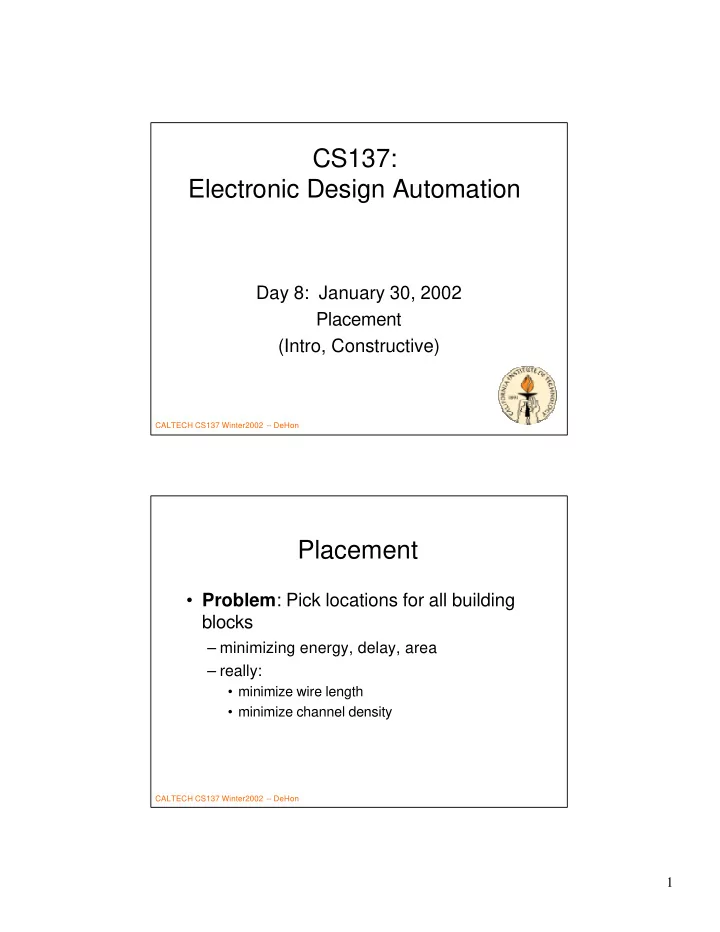

CS137: Electronic Design Automation Day 8: January 30, 2002 Placement (Intro, Constructive) CALTECH CS137 Winter2002 -- DeHon Placement • Problem : Pick locations for all building blocks – minimizing energy, delay, area – really: • minimize wire length • minimize channel density CALTECH CS137 Winter2002 -- DeHon 1
Bad Placement • How bad can it be? – Area – delay – energy CALTECH CS137 Winter2002 -- DeHon Bad: Area • All wires cross bisection • O(N 2 ) area • good: O(N) CALTECH CS137 Winter2002 -- DeHon 2
Bad: Delay • All critical path wires cross chip • Delay =O(|PATH|*2*L side ) – [and L side as O(N)] • good: O(|PATH|* L cell ) • compare 100ps gates to many nanoseconds CALTECH CS137 Winter2002 -- DeHon Bad: Energy • All wires cross chip: – O(L side ) long → O(L side ) capacitance per wire – × O(N) wires → O(N 2 ) capacitance • Good: – O(1) long wires → O(N) capacitance CALTECH CS137 Winter2002 -- DeHon 3
Distance • Can we place everything close? CALTECH CS137 Winter2002 -- DeHon “Closeness” • Try placing “everything” close CALTECH CS137 Winter2002 -- DeHon 4
Problem Characteristics • Familiar – NP Complete – local, greedy not work – greedy gets stuck in local minima CALTECH CS137 Winter2002 -- DeHon Constructive Placement CALTECH CS137 Winter2002 -- DeHon 5
Basic Idea • Partition (bisect) to define halves of chip – minimize wire crossing • Recurse to refine • When get down to single component, done CALTECH CS137 Winter2002 -- DeHon Adequate? • Does recursive bisection capture the primary constraints of two-dimensional placement? CALTECH CS137 Winter2002 -- DeHon 6
Problems • Greedy, top-down cuts – maybe better pay cost early? • Two-dimensional problem – (often) no real cost difference between H and V cuts • Interaction between subtrees – not modeled by recursive bisect CALTECH CS137 Winter2002 -- DeHon Interaction CALTECH CS137 Winter2002 -- DeHon 7
Example Ideal split “Equivalent” split (not typical) ignoring external constraints Practically -- makes all H cuts also be V cuts CALTECH CS137 Winter2002 -- DeHon Interaction CALTECH CS137 Winter2002 -- DeHon 8
Problem • Need to keep track of where things are – outside of current partition – include costs induced by above • Don’t necessarily know where things are – still solving problem CALTECH CS137 Winter2002 -- DeHon Improvement: Ordered • Order operations • Keep track of existing solution • Use to constrain or pass costs to next subproblem • Flow cut – use existing in src/sink CALTECH CS137 Winter2002 -- DeHon 9
Improvement: Constrain • Partition once • Constrain movement within existing partitions • Account for both H and V crossings • Partition next – (simultaneously work parallel problems) – easy modification to FM CALTECH CS137 Winter2002 -- DeHon Constrain Partition CALTECH CS137 Winter2002 -- DeHon 10
Improvement: Quadrisect • Solve more of problem at once • Quadrisection: – partition into 4 bins simultaneously – keep track of costs all around CALTECH CS137 Winter2002 -- DeHon Quadrisect • Modify FM to work on multiple buckets • k-way has: – k(k-1) buckets – from*to – quad → 12 • reformulate gains • update still O(1) CALTECH CS137 Winter2002 -- DeHon 11
Quadrisect • Cases (15): – (1 partition) x 4 – (2 part) x 6 = (4 choose 2) – (3 part) x 4 = (4 choose 3) – (4 part) x 1 CALTECH CS137 Winter2002 -- DeHon Recurse • Keep outside constraints – (cost effects) • Don’t know detail place • Model as at center of unrefined region CALTECH CS137 Winter2002 -- DeHon 12
Option: Terminal Propagation • Abstract inputs as terminals • Partition based upon • Represent cost effects on placement/refinement decisions CALTECH CS137 Winter2002 -- DeHon Option: Refine • Keep refined placement • Use in cost estimates CALTECH CS137 Winter2002 -- DeHon 13
Problem • Still have ordering problem • Earlier subproblems solved with weak constraints from later – (cruder placement estimates) • Solved previous case by flattening – …but in extreme give up divide and conquer CALTECH CS137 Winter2002 -- DeHon Iterate • After solve later problems • Relax solution • Solve earlier problems again with refined placements (cost estimates) • Repeat until converge CALTECH CS137 Winter2002 -- DeHon 14
Iteration/Cycling • General technique to deal with phase- ordering problem – what order do we perform transformations, make decisions? – How get accurate information to everyone • Still basically greedy CALTECH CS137 Winter2002 -- DeHon Refinement • Relax using overlapping windows • Deal with edging effects • Khang etc. claim 10- 15% improve – cycle – overlap CALTECH CS137 Winter2002 -- DeHon 15
Possible Refinement • Allow unbalanced cuts – most things still work – just distort refinement grip – allowing unbalance using FM quadrisection looks a bit tricky – gives another 5-10% improvement CALTECH CS137 Winter2002 -- DeHon Runtime • Each gain update still O(1) – (bigger constants) – so, FM partition pass still O(N) • O(1) iterations expected • assume O(1) overlaps exploited • O(log(N)) levels • Total: O(N log(N)) – very fast compared to typical annealing CALTECH CS137 Winter2002 -- DeHon 16
Uses • Good by self • Starting point for simulated annealing – speed convergence • With synthesis (both high level and logic) – get a quick estimate of physical effects – (play role in estimation/refinement at larger level) • Early/fast placement – before willing to spend time looking for best • For fast placement where time matters – FPGAs, online placement? CALTECH CS137 Winter2002 -- DeHon Summary • Partition to minimize cut size • Additional constraints to do well • Quadrisection • Keep track of estimated placement • Relax/iterate/Refine CALTECH CS137 Winter2002 -- DeHon 17
Big Ideas: • Divide-and-conquer • Successive Refinement • Phase ordering: estimate/relax/iterate CALTECH CS137 Winter2002 -- DeHon 18
Recommend
More recommend